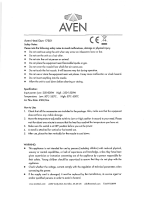
A Division of Snow Joe
®
, LLC
Model No. SPX2000
Form No. SJ-SPX2000-880E
1
OPERATOR’S MANUAL
1740 PSI/1.59 GPM Electric Pressure Washer
1740 PSI/1.59 GPM Electric Pressure Washer
© 2013 by Snow Joe, LLC
All rights reserved. Original instructions.
SAVE THESE INSTRUCTIONS
IMPORTANT!
Safety Instructions
All Operators Must Read These
Instructions Before Use
Safety Alert Symbols
Always follow these safety guidelines. Failure to do so may
result in serious bodily injury or death.
mWARNING! This indicates a hazardous situation, which,
if not avoided, could result in death or serious injury.
mCAUTION! This indicates a hazardous situation, which,
if not avoided, could result in minor or moderate injury.
mDANGER! This indicates a hazardous situation, which, if
not followed, will result in death or serious injury.
Safety Rules
m
WARNING! This appliance is not intended for use
by children or by unassisted, unsupervised persons whose
physical, sensory or mental capabilities prevent them from
using it safely. Children should be supervised to ensure that
they do not play with the appliance.
Before starting up your machine please check it carefully for
any defects. If you nd any, do not start up your machine and
contact your distributor.
mWARNING! When using the pressure washer, basic
safety precautions should always be followed to reduce the
risk of re, electric shock, and personal injury, including the
following:
• Know your product – Know how to stop the machine
and bleed pressure quickly. Be thoroughly familiar with the
controls.
• Keep bystanders away – All visitors and pets should be
kept a safe distance away from the work area.
• Use the right product – Do not use this machine for any
job except that for which it is intended.
• Dress properly – Do not wear loose clothing or jewelry.
They can get caught in moving parts. Protective rubber
gloves and non-slip footwear are recommended when
working outdoors.
• Caution! – Exercise caution to avoid slipping or falling.
Wear protective footwear that will protect your feet and
improve your footing on slippery surfaces.
• Stay alert – Watch what you are doing. Use common
sense. Do not operate the pressure washer when you are
tired, or under the inuence of alcohol or drugs.
• Do not overreach –
Keep proper footing and balance at
all times.
• Avoid unintentional starting – Do not carry plugged-in
machine with nger on the trigger. Make sure the switch is
off before plugging in the machine.
• Do not abuse the cord – Never carry the machine by the
cord or yank the cord to disconnect it from the receptacle.
Keep the cord away from heat, oil, and sharp edges.
• Use safety glasses – Also use safety footwear, snug-tting
clothing, protective gloves, hearing and head protection.
• Water temperature – Pressure washer is not meant to
pump hot water. NEVER connect it to a hot water supply as
it will signicantly reduce the life of the pump.
• Store indoors – NEVER store the pressure washer
outdoors or where it could freeze. The pump will be
seriously damaged.
• Ground Fault Circuit Interrupter (GFCI) – Protection
should be provided on the circuits or outlets to be used for
this pressure washer. Receptacles are available having built-
in GFCI protection and may be used for this measure
of safety.
• The insulation of the power cord should be faultless and
without any cracks. If the power cord is damaged, an
authorized distributor should replace it.
mWARNING! Do not use this appliance without reading
this instruction manual.
mWARNING! This appliance has been designed for
use with cleaning agents that are recommended by the
manufacturer. The use of other cleaning agents or chemicals
may adversely affect the safety of the appliance.
mWARNING! Do not use the appliance within range of
persons unless they are wearing protective clothing.
mWARNING! High pressure jets can be dangerous if
subject to misuse. The jet must not be directed at persons,
pets, live electrical equipment or the appliance itself.
• Do not direct the jet against yourself or others in order to
clean clothes or footwear.
• Risk of explosion – Do not spray ammable liquids.
• Disconnect tool – Disconnect from the electrical power
supply before performing any maintenance task.
• Keep children away – High pressure washer must not be
used by children or untrained personnel.
• To ensure appliance safety, use only original replacement
parts from the manufacturer or approved by the
manufacturer.












